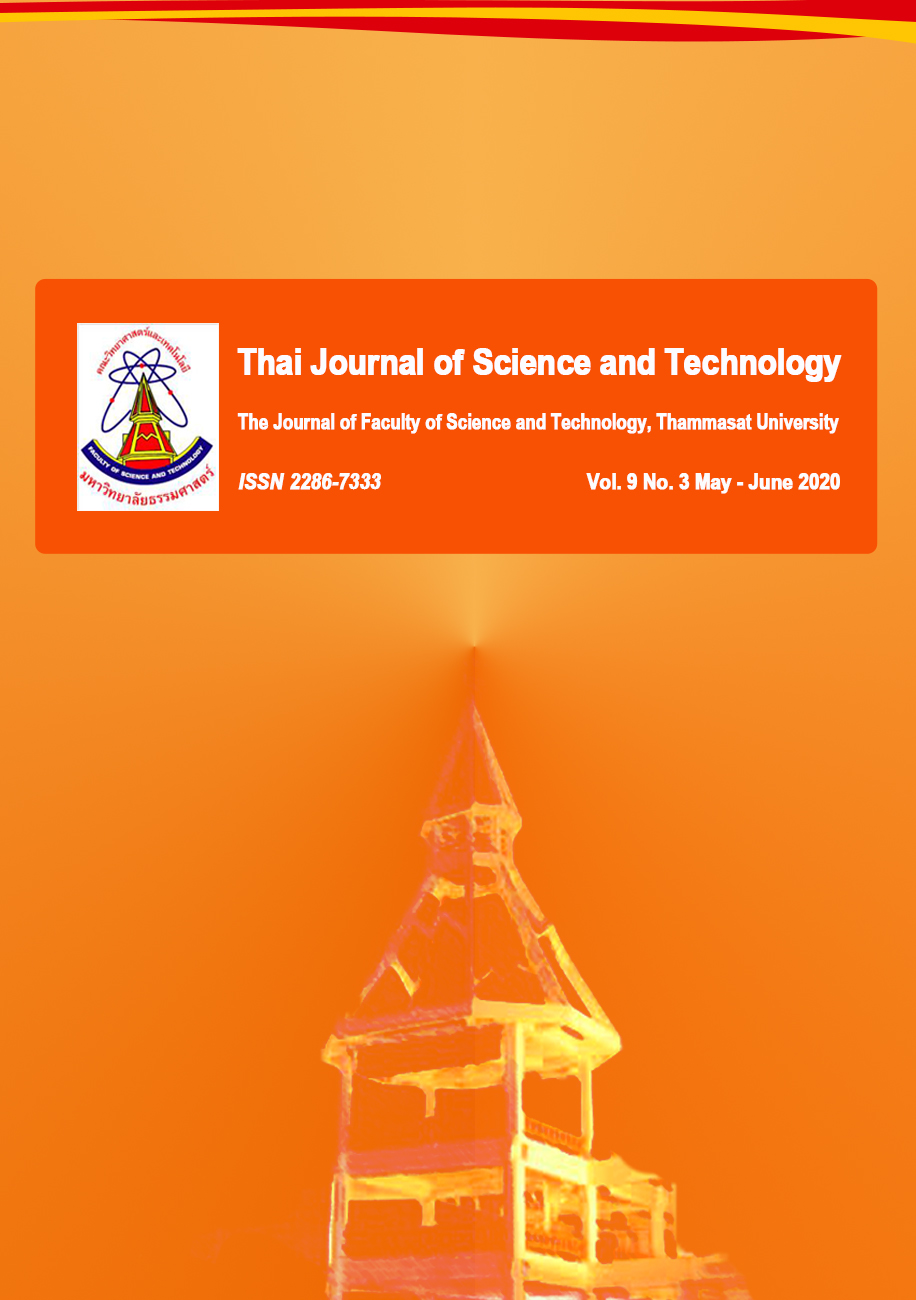Comparative Anatomy of Two Mangrove Species, Xylocarpus granatum and Xylocarpus moluccensis (Meliaceae)
Main Article Content
Abstract
Xylocarpus granatum and Xylocarpus moluccensis are true mangrove species, which are found in the central zone of mangrove forests. Anatomical character plays important roles to plant functions and adaptations to cope with certain environments. The plant samples were collected from the Sirinart Rajini Ecosystem Learning Center, Prachuabkirikhan province. Permanent slides of the samples were prepared using a paraffin method. The anatomical characters of root, stem, petiole, petiolule, rachis and leaf blade were examined and compared. The results showed that X. granatum and X. moluccensis shared their anatomical characters, i.e., tanniferous cells and crystals are common in both species. However, there are some different characteristics such as primary xylem in root, shape of vascular bundle in petiole, petiolule and leaf blade including number of hypodermis and palisade layers. Overall of this study, the anatomical character can discriminate between the two species.
Article Details
บทความที่ได้รับการตีพิมพ์เป็นลิขสิทธิ์ของคณะวิทยาศาสตร์และเทคโนโลยี มหาวิทยาลัยธรรมศาสตร์ ข้อความที่ปรากฏในแต่ละเรื่องของวารสารเล่มนี้เป็นเพียงความเห็นส่วนตัวของผู้เขียน ไม่มีความเกี่ยวข้องกับคณะวิทยาศาสตร์และเทคโนโลยี หรือคณาจารย์ท่านอื่นในมหาวิทยาลัยธรรมศาสตร์ ผู้เขียนต้องยืนยันว่าความรับผิดชอบต่อทุกข้อความที่นำเสนอไว้ในบทความของตน หากมีข้อผิดพลาดหรือความไม่ถูกต้องใด ๆ
References
Amarowicz, R., 2007, Tannins: The new natural antioxidants?, Eur. J. Lipid Sci. Technol. 109: 549-551.
Arnott, H.J. and Pautard, F.G.E., 1970, Calcification in plants, pp. 375-446, In Schraer, H. (Ed.), Biological Calcification: Cellular and Molecular Aspects, Appleton-Century-Crofts, New York.
Baas, P., Werker, E. and Fahn, A., 1983, Some ecological trends in vessel characters, IAWA Bull. 4: 141-159.
Baba, S., Chan, H.T., Kainuma, M., Kezuka, M., Chan, E.W.C. and Tangah, J., 2016, Botany, uses, chemistry and bioactivities of mangrove plants III: Xylocarpus granatum, ISME/GLOMIS Elect. J. 14: 1-4.
Cochard, H., 2006, Cavitation in trees, Comptes Rendus Physique 7: 1018-1026.
Das, S. and Ghose, M., 1996, Anatomy of leaves of some mangroves and their associates of sundarbans, west Bengal, Phytomorpho logy. 46: 139-150.
Das, S. and Ghose, M., 2003, Seed structure and germination pattern of some indian mangroves with taxonomic relevance, Taiwania 48: 287-298.
Das, S.K., Samantaray, D., and Thatoi, H., 2014, Ethnomedicinal, antimicrobial and anti diarrhoeal studies on the mangrove plants of the genus Xylocarpus: A mini review, J. Bioanal. Biomed. 12(4): 1-7.
de Menezes, N.L., 2006, Rhizophores in Rhizophora mangle L: An alternative interpretation of so-called “aerial roots”, Ann. Braz. Acad. Sci. 78: 213-226.
Esau, K., 1965, Plant Anatomy, 2nd Ed., John Wiley & Sons, Inc., New York.
Esau, K., 1977, Anatomy of Seed Plants, 2nd Ed., John Wiley & Sons, Inc., New York.
FAO, 2007, The World’s Mangroves 1980-2005, FAO Forestry Paper 153, Rome.
Franceschi, V.R. and Horner, H.T.Jr., 1980, Calcium oxalate crystals in plants, Bot. Rev. 46: 361-427.
Finley, D.S., 1999, Patterns of calcium oxalate crystals in young tropical leaves: A possible role as an anti-herbivory defense, Rev. Biol. Trop. 47: 27-31.
Giesen, W., Wulffraat, S., Zieren, M. and Scholten, L., 2007, Mangrove Guidebook for Southeast Asia, FAO and Wetlands International, RAP Publication, Bangkok.
Gill, A.M. and Tomlinson, P.B., 1977, Studies of the growth of red mangrove (Rhizophora mangle L.), the adult root system, Biotropica 9: 145-155.
Giner-chavez, B.I., 1996, Condensed Tannin in Tropical Forages, Doctoral Dissertation, Cornell University, Ithaca.
Göltenboth, F., Timotius, K.H., Milan, P.P. and Margraf, J., 2006, Ecology of Insular Southeast Asia: The Indonesian Archipelago, Elvira Bulawan-Gorre, Leyte.
Haron, N.W. and Taha, R.M., 2007, Morphological, anatomical and tissue culture studies on Xylocarpus granatum, CATRINA, Int. J. Environ. Sci. 2: 159-162.
Haron, N.W. and Taha, R.M., 2010, Taxonomy, distribution and propagation of Xylocarpus species at Carey island – The heritage island of Malaysia, Acta Hort. 881: 997-1004.
Johansen, D.A., 1940, Plant Microtechnique, McGraw Hill, New York.
Kermanee, P., 2008, Plant Microtechnique, Kasetsart University Press, Bangkok.
Kimura, M. and Wada, H., 1989, Tannins in mangrove tree roots and their role in the root environment, J. Soil Sci. Plant Nutr. 35: 101-108.
Pornpromsirikul, S., 2017, Anatomy of Mangrove Plants Genus Bruguiera Savigny (Rhizophoraceae) in Thailand, Master Thesis, Kasetsart University, Bangkok.
Pramod, S., Patel, V.R., Rajput, K.S. and Rao, K.S., 2014, Distribution of tension wood like gelatinous fibres in the roots of Acacia nilotica (Lam.) Willd, Planta 240: 1191-1202.
Ragavan, P., Saxena, M., Saxena, A., Mohan, P.M. Sachithanandam, V. and Coomar, T., 2014, Floral composition and taxonomy of mangroves of Andaman and Nicobar Islands, Indian J. Mar. Sci. 43: 1037-1050.
Ragavan, P., Saxena, A., Jayaraj, R.S.C., Ravichandran, K., Mohan, P.M. and Saxena, M., 2015, Taxonomy and distribution of little known species of the genus Xylocarpus (Meliaceae) in the Andaman and Nicobar Islands, India, Bot. Mar. 58: 415-422.
Rasmussen, G.K. and Smith, P.F., 1961, Effects of calcium, potassium and magnesium on oxalic, malic and citric acid content of Valencia orange leaf tissue, Plant Physiol. 36: 99-101.
Reef, R. and Lovelock, C.E., 2015, Regulation of water balance in mangroves, Ann. Bot. 115: 385-395.
Robert, E.M.R., Koedam, N., Beeckman, H. and Schmitz, N., 2009, A safe hydraulic architecture as wood anatomical explanation for the difference in distribution of the mangroves Avicennia and Rhizophora, Funct. Ecol. 23: 649-657.
Rodriguez, H.G., Mondal, B., Sarkar, N.C., Ramaswamy, A., Rajkumar, D. and Maiti, R.K., 2012, Comparative morphology and anatomy of few mangrove species in Sundarbans, West Bengal, India and its adaptation to saline habitat, Int. J. Bioresour. Stress Manag. 3: 1-17.
Rotond, A., Rossi, F., Asunis, C. and Cesaraccio, C., 2003, Leaf xeromorphic adaptation of some plants of a coastal Medditerranean Macchia Ecosystem, J. Mediterranean Ecol. 4(3): 25-35.
Saenger, P., 2002, Mangrove Ecology, Silviculture and Conservation, Kluwer Academic Publishers, Dordrecht.
Tomlinson, P.B., 2003, Development of gelatinous (reaction) fibers in stems of Gnetum gnemon (Gnetales), Am. J. Bot. 90: 965-972.
Thonglim, A., 2018, Anatomy of Mangrove Plants Genera Rhizophora L., Ceriops Arn. and Kandelia (DC.) Wight & Arn. in Thailand, Master Thesis, Kasetsart University, Bangkok.
Waycott, M., McKenzie, L.J., Mellors, J.E., Ellison, J.C., Sheaves, M.T., Collier, C., Schwarz, A.M., Webb, A., Johnson, J.E. and Payri, C.E., 2011, The Nature of Mangroves, Seagrasses and Intertidal Flats in the Tropical Pacific, pp. 301-303. In Bell, J.D., Johnson, J.E. and Hobday, A.J. (Eds.), Vulnerability of Tropical Pacific Fisheries and Aquaculture to Climate Change, Secretariat of the Pacific Community, Noumea.


